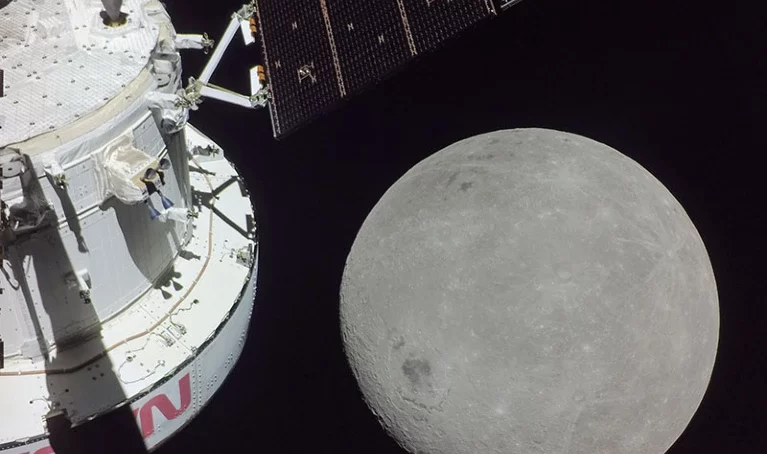
The Orion spacecraft swooped just 130 kilometres above the lunar surface on November 21, the closest a capsule designed to hold people has been to the Moon in half a century.
In the lunar darkness the capsule, which launched as part of the Artemis I mission last week, flew directly over Tranquility Base, the landing site of Apollo 11 where in July 1969 Neil Armstrong and Buzz Aldrin became the first humans to walk on the Moon.
“Today was a terrific day,” Howard Hu, NASA’s Orion programme manager, said at a press briefing.
Orion, a joint venture of NASA and the European Space Agency, is on the Artemis I uncrewed test flight to see how its capsule holds up under the stresses of deep space. So far, the spacecraft, which could carry astronauts to the Moon in as little as two years, has been doing about as well as mission controllers could have hoped, Hu said: “We have seen really good performance across the board.”
Engineers are working to troubleshoot several small glitches, such as occasional problems with Orion’s star-tracking navigational system that are likely due to damage from space radiation, as well as some intermittent issues with the electrical system that ferries power from Orion’s four solar arrays to the capsule.
Callisto, in Orion, will test voice-activated and video technology that may assist future astronauts on deep space missions.
The capsule launched on November 16, on the first-ever flight of NASA’s powerful new Space Launch System rocket, for a 26-day voyage around the Moon. Having travelled from Earth to the Moon, and performed a 2.5-minute engine burn to make its flyby, Orion has just about finished the first of three legs of its journey. On November 25, it will burn its engines to send it into the second part of its trip, a “distant retrograde orbit” of the Moon that will carry it 432,000 kilometres from Earth at its farthest point.
Images from the journey so far show Orion glimmering in reflected sunlight in deep space, occasionally with the Earth appearing as a pale blue dot in the distance or the Moon as a looming grey presence. NASA released pictures of the capsule’s interior, where a mannequin known as a ‘moonikin’ watches over control panels and a small stuffed Snoopy doll floats as an indicator of zero gravity.
Flight director Judd Frieling said that more video footage would be released soon, and that a low-resolution livestream from Orion is now available whenever communications bandwidth allows.
Artemis I is the first in a series of missions that NASA intends to launch as it prepares to return astronauts to the Moon. The next flight of Orion, Artemis II, is meant to carry four astronauts around the Moon and back as early as 2024. After that, the Artemis III flight aims to land humans at the lunar south pole, in the first crewed landing since Apollo 17 in 1971.
The Artemis I launch also carried ten small satellites into space, most of them with scientific missions. Of those, eight have been reported to have established communications with controllers after launch. But one of those, a miniature Japanese Moon lander named OMOTENASHI, began tumbling out of control and was declared lost by the Japan Aerospace Exploration Agency.
Of the two whose status is unknown, one is a solar sail designed to fly by a near-Earth asteroid. That mission, known as NEA Scout, successfully deployed off the Artemis I launch but has not been heard from since.
Separately, a small spacecraft called CAPSTONE, which launched from Earth in June and encountered some problems in September, entered its own lunar orbit on November 13. It is flying an elliptical path over the Moon’s poles, a trajectory meant to be used by a future NASA lunar space station known as Gateway.
- A Nature report











